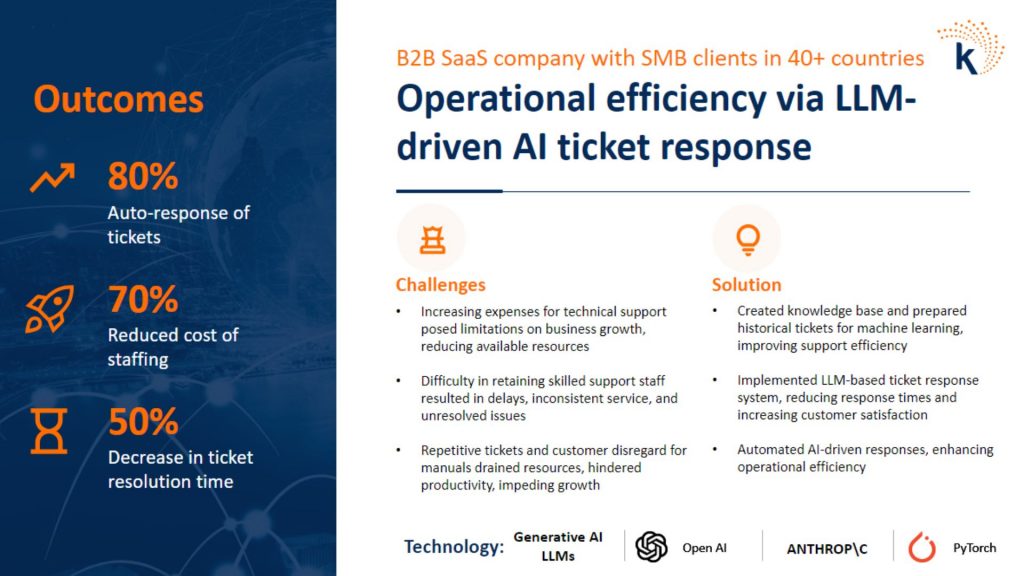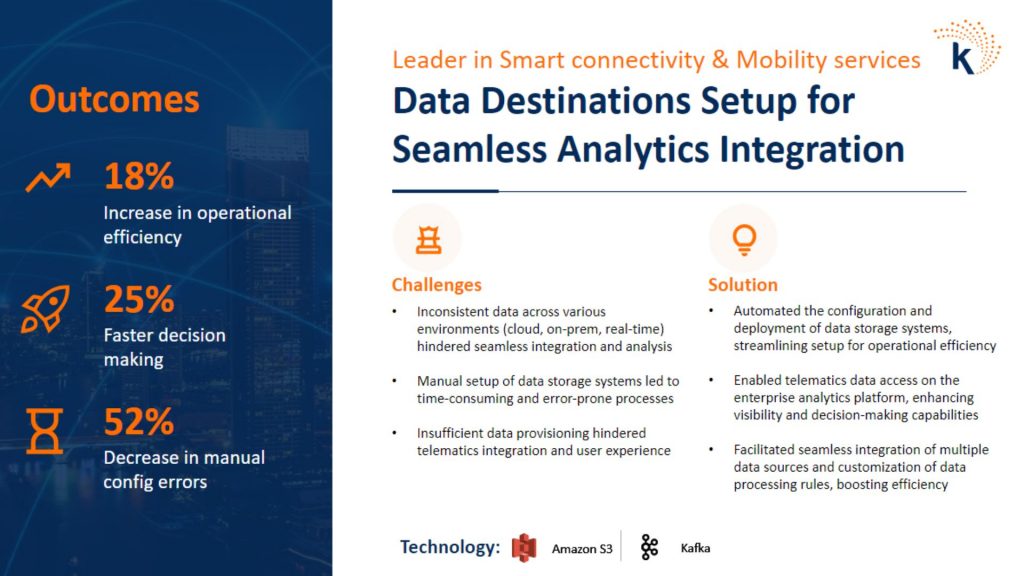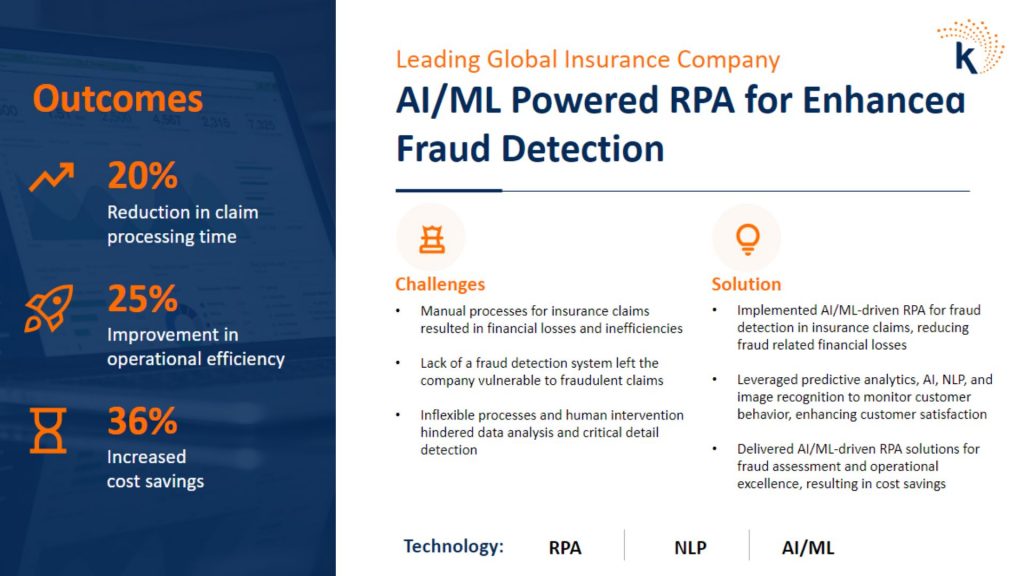The fourth Industrial Revolution is upon us, and it is spearheaded by technologies like hyperautomation, that combine the best of tech like AI and RPA.
Bill Gates has rightly quoted on the topic, ”The first rule of any technology used in a business is that automation applied to an efficient operation will magnify the efficiency.” Hyperautomation technology promises to do that and much more.
Hyperautomation’s potential has been proven true on countless occasions, as the focus of businesses have shifted from simply increasing the speed of business processes to enhancing their intelligence of these processes.
However, the concept of hyperautomation is a recent one. The term was first introduced by the research firm, Gartner in a 2019 report. Since then, hyperautomation has brought a new era of workplace innovation and productivity. Hyperautomation use cases are diverse and offer significant advantages in many sectors e.g. financial, IT service, insurance claims etc.
But what exactly is Hyperautomation and what are some of its primary use cases across industries in 2024? Let’s take a deep dive into the topic.
Table of Contents
- What is Hyperautomation?
- Understanding the Difference Between Automation and Hyperautomation
- Top Industries Benefiting from Hyperautomation Use Cases in 2024
- Top 5 Hyperautomation Use Cases Across Industries
- Hyperautomation Use Cases 1 – IT Operations and Management
- Hyperautomation Use Cases 2 – Supply Chain Management
- Hyperautomation Use Cases 3 – Data Analytics and Insights
- Hyperautomation Use Cases 4 – Customer Support
- Hyperautomation Use Cases 5 – KYC and Fraud Detection
- Let Kanerika Drive Your Hyperautomation Implementation
- FAQs
What is Hyperautomation?
Hyperautomation involves the use of multiple technologies, and platforms for automation of business processes.
It extends beyond traditional automation by incorporating advanced technologies such as artificial intelligence (AI), machine learning (ML), and robotic process automation (RPA). Many hyperautomation tools also leverage natural language processing (NLP) in their processes.
The benefits of hyperautomation tools extend beyond mere cost savings and efficiency achieved through automation. It offers agile and adaptive solutions without human intervention that are future-proof and offer businesses a competitive edge in their industries.
Also Read- Hyper Automation Trend Guide – Everything you need to know
Understanding the Difference Between Automation and Hyperautomation
Automation and hyperautomation, while related, differ in scope, and complexity. Grasping the difference between automation and hyperautomation technology is crucial for organizations to identify the right approach.
Here’s a breakdown of the differences between automation and hyperautomation:
| Key Concepts |
Automation |
Hyperautomation |
| Definition |
Automation involves using technology to perform tasks without human intervention. These tasks are typically repetitive, rule-based, and involve structured data. |
Hyperautomation refers to the end-to-end automation of complex business processes. It uses a combination of technologies, including RPA, AI, ML, process mining, analytics, and more. |
| Technology |
It primarily uses software to automate tasks. This could include simple scripts, workflow automation, or basic robotic process automation (RPA) tools. |
It integrates RPA, AI, ML, and NLP technologies to not only automate tasks but also to make intelligent decisions. Hyperautomation technology is capable of cognition. |
| Scope |
The scope of automation is usually limited to individual tasks within a process. It does not typically handle end-to-end processes or tasks that require decision-making. |
Hyperautomation technology is expansive, aiming to automate as many business processes as possible. It includes those that require some form of judgment or adaptation. |
| Intelligence |
Traditional automation lacks intelligence. It operates based on pre-defined rules and does not learn or adapt from its experiences or data. |
Hyperautomation company systems are intelligent. They can learn from data, improve over time, and make complex decisions. |
| Examples |
Automation is used by companies for accelerating sectors such as customer service, HR, manufacturing and banking services. |
Hyperautomation tools find use in highly specialized functions such as Managing Risk and Detecting Fraud in banks, and Speeding Up Claims Processing for insurance companies. |

Top Industries Benefiting from Hyperautomation Use Cases in 2024
Exploring hyperautomation use cases across industries reveals a pattern of increased efficiency and decision-making speed in industries as diverse as healthcare to telecommunications. Here is a list of industries that have readily adopted hyperautomation technology in 2024.
- Financial Services
- Healthcare
- Manufacturing
- Retail
- Telecommunications
- Energy and Utilities
- Transportation and Logistics
- Public Sector

Read More – Telematics in Insurance: How It Works and Benefits You
Top 5 Hyperautomation Use Cases Across Industries
To understand the impact of hyperautomation trends across industries, let’s take a deep dive into the top 5 hyperautomation use cases and analyze how this technology can be adopted by businesses.
We will also explore case studies for each of the hyperautomation use cases to understand the impact metrics of hyperautomation tools. Here are some hyperautomation use cases that have been most popular for US businesses in 2024:
Hyperautomation Use Cases 1 – IT Operations and Management
Hyperautomation has found a vital place in IT operations and management. It can simplify complex workflows, reduce downtime, and optimize system performance; metrics that are extremely important for IT operations in large organizations. Here is how hyperautomation technology achieves this:
Automated Incident Management:
- Problem Identification: Hyperautomation tools can monitor IT systems in real time, using AI to identify anomalies that could indicate issues.
- Incident Response: Once an issue is detected, hyperautomation platform can trigger workflows that address these problems without human intervention. For example, if a server is down, a bot can initiate a restart or switch traffic to another server.
- Resolution and Learning: Post-resolution, the system can analyze the incident to improve future responses. Machine learning algorithms can suggest changes to prevent similar issues.
Predictive Maintenance:
- System Health Monitoring: Hyperautomation tools continuously monitor the health of IT hardware and software. Predicting failures before they occur is important for continuity.
- Preventive Actions: By predicting potential system failures, hyperautomation platform can schedule maintenance tasks proactively.
Read More – Customer Service Automation: Proven Ways To Enable Efficiency
Case Study:
Kanerika delivered a transformative AI solution for a B2B SaaS company serving SMB clients across over 40 countries, achieving exceptional strides in operational efficiency through an LLM-driven AI ticket response system.

This innovation has led to an impressive 80% automation in ticket response, a substantial 70% reduction in staffing costs, and a 50% decrease in ticket resolution time.
Utilizing technologies such as Generative AI, LLMs, OpenAI, ANTHROPIC, and PyTorch, Kanerika’s strategy mitigated the issues of staff retention, resource drainage, and customer service delays.
The deployment of an LLM-based ticket response system streamlined operations, curtailing response times and heightening customer satisfaction.
Read More – Customer Service Automation: Proven Ways To Enable Efficiency
Hyperautomation Use Cases 2 – Supply Chain Management
The advantages of hyperautomation tools are particularly evident when businesses face complex challenges in supply chain management (SCM), which has forever been plagued with manual and time-consuming processes.
However, hyperautomation’s entry in the technology allows automation and artificial intelligence to work in tandem and improve the efficiency of SCM processes. Let’s take a deeper look into it:
Demand Forecasting:
- Predictive Analytics: Hyperautomation technology integrates AI and machine learning to analyze historical data and predict future demand. This helps to optimize inventory levels.
- Real-time Adjustments: Systems can automatically adjust orders and inventory in response to real-time demand fluctuations. It is easy to reduce waste and avoid stockouts.
Warehouse Automation:
- Robotics: Autonomous robots can pick and pack orders, increasing speed and reducing errors in warehouses.
- Inventory Management: IoT devices can monitor inventory levels, providing accurate data for automated restocking.
Transportation and Logistics Optimization:
- Route Optimization: AI algorithms can determine the most efficient delivery routes in real time. After considering factors like traffic, weather, and delivery windows they make the most efficient decision.
- Carrier Selection: Hyperautomation tools can select the best shipping methods and carriers. They can analyze multiple factors such as cost, delivery time, and carrier performance.
Case Study:
Kanerika engineered a cutting-edge AI-driven supply chain optimization framework that transformed a global FMCG leader’s operational efficiency.

The initiative resulted in the automation and refinement of several core business processes, notably increasing market share by 2%, decreasing order fulfillment time by 20%, and enhancing profitability by 12%.
The solution, crafted to address the challenges of volatile market conditions and complex coordination with global vendors, integrated LSTM AI models. Leveraging technologies such as TensorFlow, RNNs, Microsoft Azure, and Informatica, Kanerika’s solution substantially mitigated stock-outs, bolstered supply chain performance, and elevated customer service efficiency.

Hyperautomation Use Cases 3 – Data Analytics and Insights
Hyperautomation plays a pivotal role in enhancing data analytics and insights for businesses. By enhancing data collection, automating data processing and presenting insightful reports based on the data, hyperautomation trends can unlock key business insights that would otherwise go unnoticed by businesses.
Here is how the technology achieves this:
Enhanced Data Collection:
- Automated Data Aggregation: Hyperautomation tools can gather data from various sources, including IoT devices, online transactions, and customer interactions. This ensures a comprehensive data set for analysis.
- Data Standardization: AI algorithms can standardize disparate data formats. The action makes it easier to combine and compare data from different systems.
Advanced Data Processing:
- Real-time Analysis: Hyperautomation trends enables the real-time processing of large volumes of data, providing immediate insights.
- Predictive Analytics: ML models can analyze historical data to predict future trends, customer behaviors, and market dynamics.
Insightful Reporting:
- Automated Reporting: One of the primary advantages of hyperautomation tools is its ability to generate detailed reports and visuals. It is crucial for providing management with timely insights.
- Customizable Dashboards: Users can configure dashboards that automatically update with key performance indicators (KPIs). A clear view of business performance leads to better decision-making.
Case Study:
Kanerika propelled a leader in smart connectivity and mobility services to new heights with its custom hyperautomation solution. This resulted in an 18% increase in operational efficiency, 25% faster decision-making, and a 52% decrease in manual configuration errors for the client.

The client faced formidable challenges such as inconsistent data across different environments including cloud, on-premises, and real-time systems, which obstructed smooth integration and analysis. Furthermore, manual setups of data storage systems were laborious and prone to errors.
Kanerika’s solution was to automate the configuration and deployment of data storage systems, which significantly streamlined the setup process for better operational efficiency.
Leveraging technologies like Amazon S3 for scalable storage and Kafka for real-time data streaming, Kanerika addressed the core issues, setting a new standard for analytical integration in the smart connectivity and mobility sector.

Hyperautomation Use Cases 4 – Customer Support
Hyperautomation has significantly transformed customer support by integrating advanced technologies to enhance customer service operations.
It achieves this by automating customer interactions and personalizing the customer journey. Let’s explore these concepts in more detail:
Automated Customer Interaction:
- Chatbots and Virtual Assistants: AI-powered chatbots can handle routine inquiries and support tickets. They provide instant responses to common customer questions and can escalate more complex issues to human agents.
- Voice Recognition Systems: Advanced voice recognition and NLP enable automated systems to understand and process customer requests through phone calls. They significantly reduce wait times and improve customer satisfaction.
Personalized Customer Experience:
- Customer Journey Mapping: Hyperautomation tools can track and analyze customer interactions across multiple channels. It enables the creation of personalized experiences based on individual customer behavior and preferences.
- Targeted Support Solutions: Machine learning algorithms can predict customer issues and proactively provide solutions or information.
Efficient Issue Resolution:
- Automated Ticket Routing: RPA can automatically categorize and route support tickets to the appropriate department or agent. Optimizing response times and resolution rates increases customer retention.
- Self-Service Portals: Hyperautomation technology enables the creation of intuitive self-service portals that allow customers to find answers and resolve issues on their own.
Case Study:
Kanerika enabled a smart connectivity and mobility services company to become a market leader by bolstering emergency response safety with location-based access.

This strategic move has led to a notable 12% increase in market share, a 35% reduction in emergency response time, and a 38% improvement in delivery time.
The client was faced with multuple challenges; a fragmented platform which resulted in increased costs and inefficiencies, a lack of safety features that raised customer and driver safety concerns, and an inability to provide real-time vehicle location leading to a myriad of operational inefficiencies.
Kanerika’s solution used MongoDB for database management, Twilio for communication, and OAuth 2.0 for authorization. The integration of a geolocation algorithm into the telematics unit enabled precise vehicle tracking and control within the vehicle’s perimeter. This innovation reduced turnaround time, boosted owner control, and elevated customer satisfaction, thereby adding immense business value.
Hyperautomation Use Cases 5 – KYC and Fraud Detection
One of the most compelling hyperautomation use cases for banking and financial services companies lies in building efficient KYC verification and fraud detection mechanisms. Here is a detailed view of how Hyperautomation technology achieves these:
Streamlined KYC Processes:
- Automated Document Verification: RPA bots can quickly scan and verify documents for KYC, reducing the time required for processing.
- Customer Onboarding: AI-driven systems can automate the entire customer onboarding process, ensuring compliance with regulatory standards without sacrificing speed or customer experience.
Enhanced Fraud Detection:
- Anomaly Detection: Machine learning algorithms are trained to detect patterns and anomalies in transactions that may indicate fraudulent activity.
- Real-time Monitoring: Hyperautomation tools monitor transactions constantly, allowing for immediate action to be taken when potential fraud is detected.
Regulatory Compliance:
- Automated Compliance Checks: RPA bots ensure that all KYC and banking regulations are consistently applied.
- Regulatory Reporting: Hyperautomation trends facilitate the generation of reports for regulatory bodies, making it easier for companies to remain compliant with the latest laws.
Case Study:
Kanerika has adeptly augmented a leading global insurance company’s operations with an AI/ML-powered RPA, yielding a marked 20% reduction in claim processing time, a 25% improvement in operational efficiency, and a significant 36% increase in cost savings.

Prior to this digital transformation, the company grappled with manual processes for insurance claims, which not only caused financial losses but also operational inefficiencies. The absence of a fraud detection system exposed the company to risks associated with fraudulent claims.
To combat these issues, Kanerika implemented an AI/ML-driven RPA system specifically tailored for fraud detection in insurance claims, leading to reduced fraud-related financial losses.
Let Kanerika Drive Your Hyperautomation Implementation
As we’ve explored throughout this article, hyperautomation technology is not merely a fleeting trend – it’s a fundamental shift in the operational dynamics of businesses across industries. In 2024, from IT operations to supply chain management, compliance, and beyond, hyperautomation has proven its mettle by enabling unparalleled efficiency, agility, and innovation.
But this technology can only reach its full potential if it is implemented the right way.
This is where Kanerika steps in, bringing a decade of rich experience in automation, robotics, and artificial intelligence to the forefront of this hyperautomation revolution.
Kanerika’s approach is centered around low-investment yet highly tailored solutions, designed to meet the unique demands of your business.
With over 500 companies already experiencing the transformative impact of Kanerika’s custom solutions – slashing costs and dramatically enhancing performance – the evidence of Kanerika’s expertise is clear.
Reach out to Kanerika’s experts today and start the journey towards an optimized, agile, and hyperautomated future for your organization.

FAQs
What is Hyperautomation used for?
Hyperautomation technology is used for enhancing business process automation beyond conventional methods. It integrates advanced technologies like AI, ML, and RPA to automate complex, end-to-end business processes, optimizing operational efficiency, reducing costs, and enabling intelligent decision-making.
What is Hyperautomation examples?
- IT Operations: Automated incident management and predictive maintenance.
- Supply Chain Management: Demand forecasting and warehouse automation.
- Customer Support: AI-powered chatbots and virtual assistants.
- Data Analytics and Insights: Automated data aggregation and analysis.
- KYC and Fraud Detection: Enhanced fraud detection mechanisms in banking.
What is Hyperautomation vs automation?
Hyperautomation trends extend beyond traditional automation by integrating advanced technologies like AI, ML, and RPA to handle complex business processes. While automation focuses on individual tasks, often repetitive and rule-based, hyperautomation aims at end-to-end process automation, capable of making intelligent decisions.
What are the four 4 types of automation?
- Basic Automation: Handling repetitive, rule-based tasks.
- Process Automation: Streamlining business processes.
- Integration Automation: Connecting different systems and software.
- Artificial Intelligence (AI) and Machine Learning (ML) Automation: Enabling systems to learn from data and make intelligent decisions.
What problem does Hyperautomation solve?
Hyperautomation use cases address issues like operational inefficiency, high processing time, error-prone manual tasks, and the inability of traditional automation to handle complex processes. It enhances decision-making, optimizes resource utilization, and enables agility in adapting to new challenges.
What industries use Hyperautomation?
Industries like financial services, healthcare, manufacturing, retail, telecommunications, energy and utilities, transportation and logistics, and the public sector extensively use hyperautomation tools for various operational improvements.